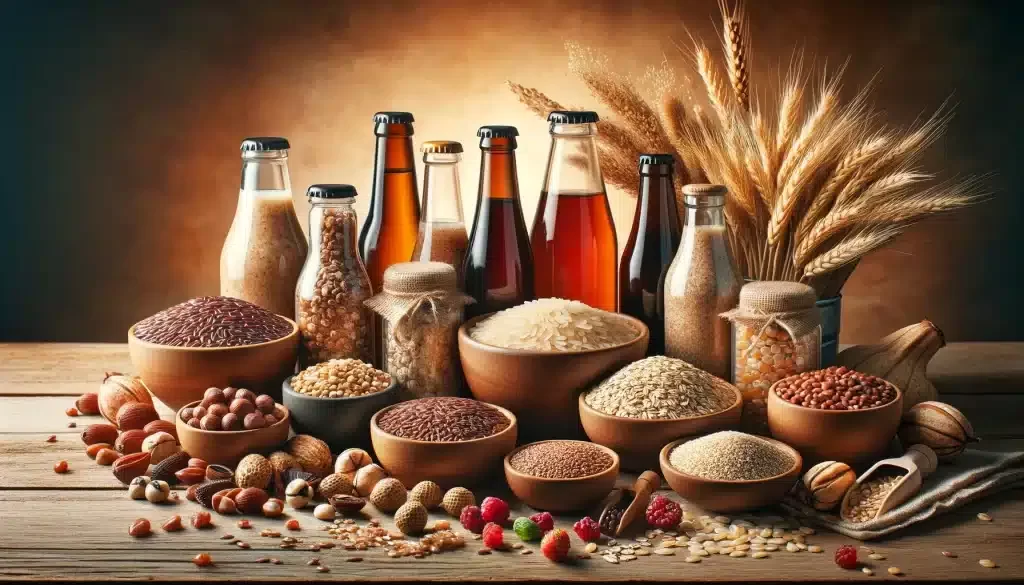Whole Grain Beverages: The New Trend in Beverage Development
Explore the health benefits of whole grain beverages, a key trend in nutritious, plant-based drinks for a balanced diet and wellness.
As obesity gradually becomes a prevalent nutritional issue worldwide, the importance of increasing dietary fiber intake and consuming more whole grains for health is gaining increasing attention. The ancient Chinese medical text “Huangdi Neijing” (The Yellow Emperor’s Classic of Internal Medicine) already contains the principle of dietary cultivation that states, “Five grains nourish, five fruits support, five animals benefit, and five vegetables fill. Combine flavors and consume them to replenish essence and boost qi,” which also highlights the dominant role of mixed grains in the diet.
What Are Whole Grains?
In China’s traditional dietary pattern, grains are the staple, referring to the seeds of cereals, including rice, wheat, corn, barley, millet, sorghum, oats, and buckwheat. The structure of various grains is fundamentally similar, comprising the bran, endosperm, and germ after the husk is removed. The bran, the outer layer of the seed, consists mainly of dietary fiber, B vitamins, minerals, and phytochemicals. The endosperm, the central part of the seed, makes up 85% of its weight, primarily composed of starch and a small amount of protein. The germ, the part of the seed that sprouts, is rich in protein, fats, unsaturated fatty acids, vitamin E, B vitamins, and minerals.
Difference Between Whole and Refined Grains
Refined grains, such as polished rice and white flour, undergo extensive processing, removing the bran and germ, thus losing many nutrients, especially dietary fiber, B vitamins, vitamin E, and unsaturated fatty acids. In contrast, whole grains like brown rice and whole wheat flour, or grains that still retain all natural components after processing, are considered whole grains, keeping the bran, endosperm, and germ, thus preserving a lot of dietary fiber and nutrients. Corn, millet, red rice, black rice, purple rice, sorghum, oats, buckwheat, legumes like green beans, red beans, black beans, broad beans, peas, chickpeas, and tubers like sweet potatoes, yams, potatoes, and taro are all whole grains.
Nutritional Value of Whole Grains
Recognizing the nutritional value and health benefits of whole grains, the 2022 edition of the “Dietary Guidelines for Chinese Residents” recommends varying intake levels based on age. For healthy adults, it’s advised to consume 50-150 grams of whole grain foods daily, accounting for a quarter to a third of daily grain intake, ensuring at least one meal a day includes whole grains or legumes.
Whole grains contain more dietary fiber compared to refined grains; for instance, the fiber content in brown rice is six times that of white rice. Dietary fiber is beneficial for maintaining intestinal health, preventing constipation, promoting the growth of beneficial gut bacteria, improving barrier function and immunity, lowering the glycemic index and cholesterol levels, thereby reducing the risk of obesity, type 2 diabetes, cardiovascular diseases, and some cancers. Furthermore, increasing dietary fiber intake can enhance satiety, reducing calorie intake and aiding in weight management. Some dietary fibers, like soluble fiber, can promote the absorption of nutrients such as calcium and iron by fermenting in the colon.
Protein and Carbohydrates in Whole Grains
Grains are an important protein source, with a content of about 8%-12%. Oats and legumes are particularly rich in protein, around 20%. Grains are also the main source of carbohydrates, providing energy, and are traditionally the staple food in China. Grains contain about 40%-70% carbohydrates, while legumes have about 50%-60%.
Low Fat Content and Market Status of Whole Grain Beverages
Grains have a low fat content, primarily unsaturated fatty acids, making them a healthier choice. With China’s economic growth, improvements in living standards, and heightened health awareness, there’s a shift towards nutritious, functional, and health-oriented beverages. Whole grain beverages, aligning with the natural, nutritious, and healthy market trend, are increasingly favored. The traditional Chinese habit of consuming whole grains supports the popularity of whole grain beverages as a convenient nutrition source. The market for these beverages is growing, with new products continually being introduced, meeting the diverse tastes and health needs of consumers, and showing a promising future driven by health trends and plant-based preferences.
About ETprotein:
ETprotein, a reputable rice protein Chinese factory manufacturer and supplier, is renowned for producing, stocking, exporting, and delivering the highest quality organic bulk vegan protein and plant proteins. They include Organic rice protein, clear rice protein, pea protein, clear pea protein, pumpkin seed protein, sunflower seed protein, mung bean protein, etc. Our offerings, characterized by a neutral taste, non-GMO, allergen-free attributes, cater to a diverse range of industries. We serve nutraceutical, pharmaceutical, cosmeceutical, veterinary, as well as food and beverage finished product distributors, traders, and manufacturers across Europe, USA, Canada, Australia, Thailand, Japan, Korea, Brazil, and Chile, among others.
Our specialization includes exporting and delivering tailor-made protein powder and finished nutritional supplements. Our extensive product range covers sectors like Food and Beverage, Sports Nutrition, Weight Management, Dietary Supplements, Health and Wellness Products, and Infant Formula, ensuring comprehensive solutions to meet all your protein needs.
As a trusted company by leading global food and beverage brands and Fortune 500 companies, ETprotein reinforces China’s reputation in the global arena. For more information or to sample our products, please contact us and email sales(at)ETprotein.com today.












